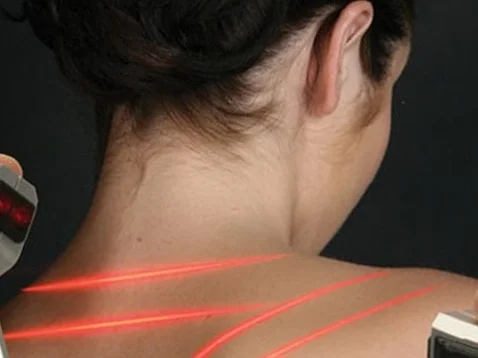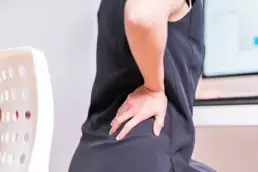How does Denver laser therapy for pain work? You might have seen the ads or heard people mention using lasers for various health procedures. Its most common uses are for pain relief and healing. Laser therapy is medically recommended in clinical practice guidelines for chronic neck and lower back pain.
Table of Contents
ToggleHow Does Light Affect Human Tissue?
Laser therapy uses light to produce a specific stimulatory effect on biological tissues, usually repair, regeneration, and pain reduction. Laser and LED light to stimulate the body’s healing mechanisms is called “photobiomodulation.” But for this post, we’ll use the simpler term “laser therapy.”
People have wondered if and how laser therapy has worked since the 1960s. A Hungarian surgeon named Endre Mester accidentally found that red lasers stimulated faster hair growth in mice.
Since then, over 4000 studies have been conducted on laser therapy and hundreds of conditions (nearly 400 studies were published in 2020 alone). These studies show laser therapy’s excellent safety and powerful effects on painful conditions.
How Does Denver Laser Therapy for Pain Work?
For light to affect tissues, you need three things…
- Absorption of light energy by critical cellular components.
- Penetration of light to the tissues’ depth to be affected.
- An adequate dose is delivered to that depth.
Light is absorbed by colored matter that matches the light’s wavelength. Take the example of wearing a dark shirt outside on a sunny day. You’ll get much warmer wearing a dark shirt than a light-colored one because the dark material absorbs the sun’s UV and far-infrared waves more easily.
“Colored” chromophores absorb wavelengths in human cells in the 640-1100nm spectrum (visible red through near-infrared). Two chromophores are cytochrome C oxidase and mitochondrial-bound water molecules, essential components in the mitochondrial production of ATP.
When CCO and bound water absorb this near-infrared light, they change conformation and position, increasing the ATP formation rate.
Laser therapy is a complex device that fixes a simple problem… PAIN!
This process also releases limited amounts of nitric oxide (NO) and reactive oxygen species (ROS), which activate transcription factors for growth factors and mediator proteins involved in wound healing. NO also causes vasodilation that improves the transport of oxygen and immune cells to the tissue leading to enhanced cell repair.
Red and infrared light enhances phagocytosis, angiogenesis, collagen synthesis, keratinocyte, and fibroblast proliferation.
Laser therapy induces changes in blood flow and microcirculation. These actions stimulate healing by increasing oxygen levels and reducing edema. This speeds healing after an injury and creates the environment that helps injury repair the environment after an injury.
Laser Therapy Penetration
Most people don’t think light can travel through the tissues, but the right kind of light definitely can. Think about shining a flashlight through one side of your hand and seeing your hand glow red- that’s an example of light penetrating the tissues and even coming out the other side.
Near-infrared light at 800-1100nm can go quite deep into the tissues, even going right through bone! Good penetration of light allows the absorption of photons in deep tissue injuries. As we saw above, these wavelengths produce many beneficial cellular effects.
One thing before we move on, even with good penetration, light is absorbed and diffused into the tissues, and you get less and less light the deeper you go.
Different Types of Medical or “Cold” Lasers
Laser devices are divided into classes based on their power output. There are two main types that you’ll find in a PT or chiropractic office: Class 3 and Class 4 units, with Class 3 machines producing 0.5 watts or less and Class 4 lasers producing more than 0.5 watts. Both classes of therapy lasers are safe to operate.

Is Denver Low-Level Laser Therapy for Pain Safe?
The main difference between the two classes is that class 4 units deliver their doses faster than class 3 machines. A quick example: providing 400 J with a 0.5W class 3 machine will take more than 13 minutes, while a 5W class 4 machine will take less than 2 minutes.
This higher power is important when treating injuries to deeper tissues such as ligaments, muscles, tendons, and cartilage. Beam intensities greater than 1W significantly improve light transmission through soft tissues compared to lower beam intensities.
Several published reports have questioned low-power lasers’ ability to transmit energy beyond the skin into deep tissues effectively.
What Conditions Can Cold Laser Therapy Help?
Now that we’ve checked the box for properly exploring the question, “How does laser therapy work?”. You may recall I talked about evidence for laser therapy’s effectiveness at the top of the article. Here are a few conditions that respond well to laser therapy.
- Neuropathy: Laser therapy “has beneficial effects on the recovery of nerve lesions, especially when related to a faster regeneration and functional improvement.”
- Headache Treatment: Laser for chronic migraines is just as effective as Botox injections while being cheaper and reducing sleep disturbance better.
- Musculoskeletal Conditions: 94% of articles in this study on class 4 laser for musculoskeletal pain revealed positive effects, including with complex cases like whiplash injuries.
- Athletic Performance: Light therapy produces better muscle recovery and gains strength post-exercise than ice while reducing soreness.
- Complex Diseases: Light therapy can raise the standard of care and improve patients’ quality of life for a fraction of the cost of many current approaches. “Progress will lead to the imminent inception of light therapy as a mainstream treatment for multiple complex diseases… it is time to consider light therapy as a potential drug equivalent.”
So, How Does Laser Therapy Work for Pain?
Specific light colors induce faster ATP production, increasing NO and ROS, causing vasodilation for improved blood flow and cellular repair. Laser therapy produces great results in dozens of conditions when used with the right equipment and techniques. Those conditions range from neuropathy and arthritis to both acute and chronic lower back injuries.
Because you’re merely accelerating the body’s natural healing processes, this perfectly aligns with the drug-free natural healing philosophy that most chiropractors operate with. Light therapy also reduces pain and the number of painkillers and anti-inflammatory drugs are taken, reducing the dangers of these harmful drugs.
Interested in Low-Level Laser therapy? Our office is conveniently located for patients in Arvada, Denver, and Wheat Ridge, Colorado! Still not sure? Check out some of our 5-Star Google reviews and see what our happy, healthy, pain-free patients have to say.

Ready for an expert opinion? Get in touch today!
With a legacy of more than 25 years, our team specializes in helping individuals triumph over back pain, neck discomfort, and persistent headaches, all without relying on addictive medications or risky surgical procedures.





